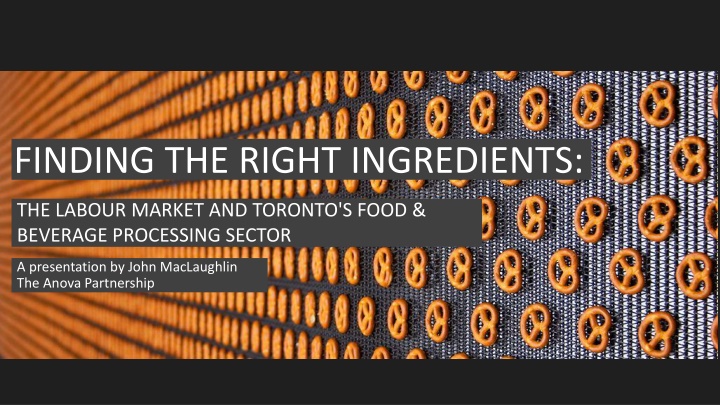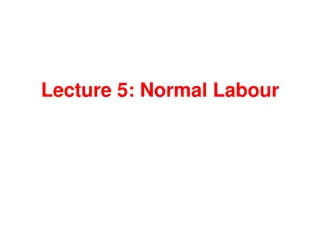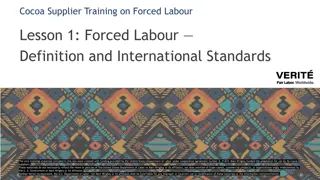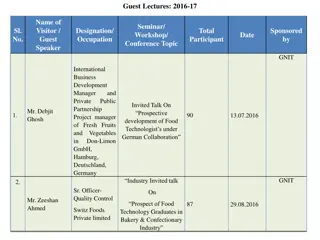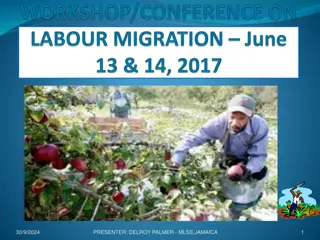Labour Market and Toronto's Food & Beverage Processing Sector
This presentation by John MacLaughlin of The Anova Partnership delves into the importance of the food and beverage production sector in the Greater Toronto Area and Ontario. It explores the growth, key subsectors, employment statistics, and the impact on the region's economy.
Download Presentation

Please find below an Image/Link to download the presentation.
The content on the website is provided AS IS for your information and personal use only. It may not be sold, licensed, or shared on other websites without obtaining consent from the author.If you encounter any issues during the download, it is possible that the publisher has removed the file from their server.
You are allowed to download the files provided on this website for personal or commercial use, subject to the condition that they are used lawfully. All files are the property of their respective owners.
The content on the website is provided AS IS for your information and personal use only. It may not be sold, licensed, or shared on other websites without obtaining consent from the author.
E N D
Presentation Transcript
FINDING THE RIGHT INGREDIENTS: THE LABOUR MARKET AND TORONTO'S FOOD & BEVERAGE PROCESSING SECTOR A presentation by John MacLaughlin The Anova Partnership
THE SECRET LIVES OF STATISTICIANS: SURVEY SAYS FOOD AND BEVERAGE PRODUCTION IS CRITICALLY IMPORTANT FOR THE GTA AND ONTARIO A presentation by John MacLaughlin The Anova Partnership
WTF ARE YOU DOING IM JUST A DUMPER: TALES FROM THE PRODUCTION LINE A presentation by John MacLaughlin The Anova Partnership
HOW FOOD FACTORY CHANGED MY LIFE: A DECADE OF WORKING AROUND FOOD A presentation by John MacLaughlin The Anova Partnership
OVERVIEW Elevate Canada. Finding the Right Ingredients. Manufacturing Study of Toronto, Peel, Halton and York Region. Contract Food Study. Working Paper on ASO s Daily Lectures from the expert . A living example of a Career Pathway in Food.
FOOD AND BEVERAGE - LARGEST SUBSECTOR Manufacturing by subsector - Toronto Petroleum Leather and allied products Primary metal Textile Mills Beverage and tobacco Paper Manufacuring Textile product mills Transportation equipment Electrical equipment, appliance and components Wood Products Non-metallic mineral products Chemical manufacturing Plastics and rubber products Computer and electronic products Machinery Clothing manufacturing Furniture and related products Miscellaneous manufacturing Fabricated metal product s Printing and related support activities Food manufacturing 0 100 200 300 400 500 600
FOOD AND BEVERAGE MANUFACTURING SECTOR Moderate Growth In Toronto Over Past Decade mostly in Baking and Beverage Third Largest Cluster In North America Currently Employs Over 70,000 People In The Greater Toronto Region With Sales Of About $18 Billion The jobs are not so different than those in industrial kitchens Move to smaller and hybrid firms reflecting artisan production
FOOD AND BEVERAGES PRODUCTION ITS EVERYWHERE
Average Hourly Wage, All Occupations in Food and Beverage Manufacturing, Toronto CMA $27.00 $25.00 $23.00 $21.00 $19.00 Average Hourly Wage in 2016 $ $17.00 $15.00 2005 2006 2007 2008 2009 2010 2011 2012 2013 2014 2015 2016
IN SHORT AGING WORKFORCE MINUS FEWER ENTRANTS INTO LABOUR FORCE + F&B INDUSTRY GROWTH = BIG TROUBLE
WHAT DO EMPLOYERS WANT? The skills and attributes sought by employers vary and appear to be aligned with desired workplace culture. All employers cited the importance of soft skills such as positive attitude, reliability and punctuality. Most of the firms do not require any specific education or training for entry-level production positions. Many of the larger firms draw heavily on recent and established immigrants to fill production positions. Some companies face an aging production workforce (across all occupations) and several remarked on their inability to attract younger workers.
WORKING CONDITIONS Variety in working conditions. Employees in many production facilities have to do repetitive tasks, standing for extended periods, and high levels of noise. Wages across employers vary. Some companies pay new production workers minimum wage and offer minimal or intermittent wage increases. Others offer starting wages of $14 to $16 and provide wage increases on a regular basis. Salaries appear to top out around $18 to $19 for most production positions. Other occupations are paid at competitive rates (sanitation, office, and sales). Most employers indicated that they provide benefits. Several also offer bonuses and non-monetary incentives. Many firms offer solid opportunities for advancement Small operations call for individuals who can multi-task and do different types of jobs.
KEY INSIGHTS Significant labour demand and increasing wages in both Ontario and Toronto CMA. Reliance on temporary workers nature of the beast. Bakeries, meat production, beverages and other industry groups dominate Toronto. The huge increase in number of Hybrid Food Firms and they face big challenges. Decrease in large manufacturers, increase in small manufacturers. Industrial Kitchens increasing at rapid pace.
KEY INSIGHTS Despite conventional wisdom, food production is evenly spread across all regions of Toronto. The food and beverage manufacturing labour force is aging at a rapid pace. Publically funded workforce development system is not designed to deal with small firms and has a bad attitude to jobs in the industry ..but signs this is changing. Elevate at PTP, HWTC, Sector and possible ASO pilot in Food (Chicagoland).
QUESTIONS? THANK YOU
